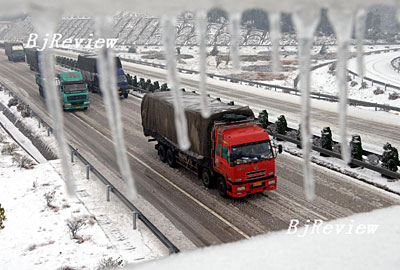|

China has spent the month leading up to the biggest holiday, the Spring Festival, in a nationwide battle against the biggest snow-fueled disaster since its national meteorological networks started in the 1950s.
The heavy snowfalls and sleet accompanied by abnormally low temperatures from January 10 had frozen vast southern provinces causing treacherously icy roads, downed power lines, frozen vegetables dead in the field, collapsed buildings and widespread power blackouts. The average temperatures in China's eastern, central and northwestern provinces in January were at least 2 degrees Celsius lower than those of a normal year, which slowed down the melting of snow or ice on the ground.
South China's power transmission facilities were ill prepared for such extreme weather. Frozen snow and sleet knocked out electricity lines and poles in several provinces, leaving their residents without power and railway traffic passing through these areas totally paralyzed. China Meteorological Administration (CMA) spokeswomen Jiao Meiyan explained that most electricity lines in southern provinces were designed to take the weight of 15 mm of ice, but in many areas 50 mm-60 mm of ice was on them this winter.
In worst-hit provinces, including Hubei, Hunan, Guizhou, Jiangxi, Anhui and Jiangsu, local governments had to deal with the immediate challenges of de-icing highways jammed with stranded vehicles, recovering power supplies to affected areas and ensuring coal shipments to power plants.
Guaranteeing food supplies for urban residents became another urgent task for both central and local governments. Short supplies of farm produce in cities, whose production and shipping had been devastated by the snowfall, led to a vicious round of price rises for essential daily items.
A meeting of the State Council, or the cabinet, on February 1, decided that the top priorities were to keep road traffic moving, ensure power supplies and guarantee people's daily lives were normal. The meeting urged stronger efforts to repair damaged rail lines and stressed the importance of transporting coal and living necessities to supply Spring Festival markets. A command center was established directly under the State Council to coordinate contingency measures for coal, oil and power supply, as well as transportation and disaster relief.
By the number
The Ministry of Civil Affairs announced that by the evening of January 31, extreme weather in 18 provinces and autonomous regions had caused 60 deaths, forced the resettlement of 1.76 million people and affected 485,000 hectares of farmland. The direct economic losses had reached 5.39 billion yuan ($747 million).
By January 31, the Central Government had pooled a total of 431 million yuan ($59.9 million) into the fund for disaster relief.
The Ministry of Information Industry reported that by January 30, in snowstorm-hit areas, telecom services had been restored for 11.9 million users, which accounted for 60 those affected. The damages to telecom facilities caused direct economic losses of nearly 150 million yuan ($20.8 million).
Power the top priority
Repairing the power grid was slowed down by frozen ice on highways, which had paralyzed traffic. Blocked roads and railways also choked coal shipments to thermal power plants.
More than 30 million people were affected by snow-triggered power shortages, blacking out provinces, including populous eastern Anhui, Jiangsu and southern Guangdong, according to a Xinhua report on January 30.
| 